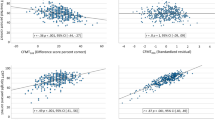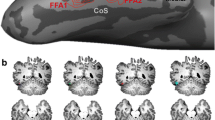This paper reviews studies on the face inversion effect and expertise. It is suggested that the inversion effect be considered as evidence of specific processing in face recognition or expertise of the objects, which meet three prerequisites. Some disputes are also pointed out in the review. It is proposed that further studies should be addressed to the visual differences, physiological basis of cognitive modules, and anatomical and functional location of the respective networks.
Similar content being viewed by others
References
R. K. Yin, “Looking at upside-down faces,” J. Exp. Psychol., 81, 141–145 (1969).
B. Rossion and A. Boremanse, “Nonlinear relationship between holistic processing of individual faces and picture-plane rotation: Evidence from the face composite illusion,” J. Vis., 8, No. 4, 1–13 (2008).
V. Bruce and A. Young, “Understanding face recognition,” Br. J. Psychol., 77, Part 3, 305–327 (1986).
B. Rossion and I. Gauthier, “How does the brain process upright and inverted faces?” Behav. Cogn. Neurosci. Rev., 1, No. 1, 63–75 (2002).
N. Sagiv and S. Bentin, “Structural encoding of human and schematic faces: Holistic and part-based processes,” J. Cogn. Neurosci., 13, No. 7, 937–951 (2001).
M. Picozzi, V. M. Cassia, C. Turati, and E. Vescovo, “The effect of inversion on 3- to 5-year-olds’ recognition of face and nonface visual objects,” J. Exp. Child Psychol., 102, No. 4, 487–502 (2009).
K. Linkenkaer-Hansen, J. M. Palva, M. Sams, et al., “Face-selective processing in human extrastriate cortex around 120 ms after stimulus onset revealed by magnetoand electroencephalography,” Neurosci. Lett., 253, No. 3, 147–150 (1998).
N. Kanwisher, J. McDermott, and M. M. Chun, “The fusiform face area: A module in human extrastriate cortex specialized for face perceptionm,” J. Neurosci., 17, No. 11, 4302–4311 (1997).
J. V. Haxby, E. A. Hoffman, and M. I. Gobbini, “The distributed human neural system for face perception,” Trends Cogn. Sci., 4, No. 6, 223–233 (2000).
N. Kanwisher, P. Downing, R. Epstein, and Z. Kourtzi, “Functional neuroimaging of human visual recognition,” in: The Handbook on Functional Neuroimaging, R. Cabeza and A. Kingstone (eds.), MIT Press, Cambridge (2001), pp. 109–152.
M. Moscovitch, G. Winocur, and M. Behrmann, “What is special about face recognition? Nineteen experiments on a person with visual object agnosia and dyslexia but normal face recognition,” J. Cogn. Neurosci., 9, No. 5, 555–604 (1997).
D. Anaki, Y. Kaufman, M. Freedman, and M. Moscovitch, “Associative (prosop)agnosia without (apparent) perceptual deficits: A case-study,” Neuropsychologia, 45, No. 8, 1658–1671 (2007).
J.-F. Delvenne, X. Seron, F. Coyette, and B. Rossion, “Evidence for perceptual deficits in associative visual (prosop)agnosia: A single-case study,” Neuropsychologia, 42, No. 5, 597–612 (2004).
B. de Gelder and R. Rouw, “Paradoxical configuration effects for faces and objects in prosopagnosia,” Neuropsychologia, 38, No. 9, 1271–1279 (2000).
T. Busigny and B. Rossion, “Acquired prosopagnosia abolishes the face inversion effect,” Cortex, 46, No. 8, 965–981 (2010).
D. A. Minnebusch, P. M. Keune, B. Suchan, and I. Daum, “Gradual inversion affects the processing of human body shapes,” NeuroImage, 49, No. 3, 2746–2755 (2010).
Z. Hussain, A. B. Sekuler, and P. J. Bennett, “Perceptual learning modifies inversion effects for faces and textures,” Vision Res., 49, No. 18, 2273–2284 (2009).
J. W. Tanaka and T. Curran, “A neural basis for expert object recognition,” Psychol. Sci., 12, No. 1, 43–47 (2001).
L. S. Scott, J. W. Tanaka, D. L. Sheinberg, and T. Curran, “A reevaluation of the electrophysiological correlates of expert object processing,” J. Cogn. Neurosci., 18, No. 9, 1453–1465 (2006).
K. M. Curby, K. Glazek, and I. Gauthier, “A visual short-term memory advantage for objects of expertise,” J. Exp. Psychol. Human Percept. Perform., 35, No. 1, 94–107 (2009).
B. Rossion, I. Gauthier, V. Goffaux, et al., “Expertise training with novel objects leads to left-lateralized facelike electrophysiological responses,” Psychol. Sci., 13, No. 3, 250–257 (2002).
B. Rossion, “Distinguishing the cause and consequence of face inversion: The perceptual field hypothesis,” Acta Psychol., 132, No. 3, 300–312 (2009).
I. Gauthier and M. J. Tarr, “Becoming a ‘greeble’ expert: Exploring mechanisms for face recognition,” Vision Res., 37, No. 12, 1673–1682 (1997).
B. Rossion, I. Gauthier, M. J. Tarr, et al., “The n170 occipito-temporal component is delayed and enhanced to inverted faces but not to inverted objects: An electrophysiological account of face-specific processes in the human brain,” NeuroReport, 11, No. 1, 69–74 (2000).
A. M. Proverbio, M. D. Zotto, and A. Zani, “Greek language processing in naive and skilled readers: Functional properties of the Vwfa investigated with ERPs,” Cogn. Neuropsychol., 23, No. 3, 355–375 (2006).
R. J. Itier and M. J. Taylor, “Effects of repetition learning on upright, inverted and contrast-reversed face processing using ERPs,” NeuroImage, 21, No. 4, 1518–1532 (2004).
E. Halgren, T. Raij, K. Marinkovic, et al., “Cognitive response profile of the human fusiform face area as determined by MEG,” Cerebr. Cortex, 10, No. 1, 69–81 (2000).
T. Nakashima, K. Kaneko, Y. Goto, et al., “Early ERP components differentially extract facial features: Evidence for spatial frequency-and-contrast detectors,” Neurosci. Res., 62, No. 4, 225–235 (2008).
A. Sekunova and J. J. Barton, “The effects of face inversion on the perception of long-range and local spatial relations in eye and mouth configuration,” J. Exp. Psychol. Human Percept. Perform., 34, No. 5, 1129–1135 (2008).
G. Yovel, “The shape of facial features and the spacing among them generate similar inversion effects: A reply to Rossion (2008),” Acta Psychol., 132, No. 3, 293–299 (2009).
Y. Xu, J. Liu, and N. Kanwisher, “The n170 is selective for faces, not for expertise,” Neuropsychologia, 43, No. 4, 588–597 (2005).
M. J. Farah, C. Rabinowitz, G. E. Quinn, and G. T. Liu, “Early commitment of neural substrates for face recognition,” Cogn. Neuropsychol., 17, No. 1, 117–123 (2000).
M. J. Tarr and I. Gauthier, “FFA: A flexible fusiform area for subordinate-level visual processing automatized by expertise,” Nat. Neurosci., 3, No. 8, 764–769 (2000).
Author information
Authors and Affiliations
Corresponding author
Rights and permissions
About this article
Cite this article
Gong, J., Zhang, Y., Huang, Y. et al. Controversies in the Facial Inversion Effect: Face Specificity and Expertise. Neurophysiology 46, 438–443 (2014). https://doi.org/10.1007/s11062-015-9470-9
Received:
Published:
Issue Date:
DOI: https://doi.org/10.1007/s11062-015-9470-9




